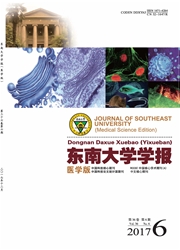

 中文摘要:
中文摘要:
目的:构建结缔组织生长因子多肽(CTGFP)超微超顺磁氧化铁粒子(USPIOs)磁共振(MR)分子探针,以显示高表达整合素αvβ3受体人肝癌Bel7402细胞。方法:用免疫细胞化学方法检测Bel7402细胞αvβ3受体表达情况;用邻苯二马来酰亚胺(OPDM)将USPIO和CTGFP偶联;将USPIO—CTGFP、USPIO分别与Bel7402细胞孵育,同时设立多肽竞争组及对照组,行普鲁士蓝染色显示铁颗粒,体外磁共振成像(MRI)观察在T2*WI上T2弛豫时间变化。结果:Bel7402细胞αvβ3受体表达阳性;普鲁士蓝染色可见USPIO—CTGFP组铁颗粒分布在细胞膜,而USPIO组及竞争组细胞膜上和细胞内铁颗粒极少;体外MRI显示USPIO—CTGFP组T2弛豫时间低于USPIO组、竞争组及对照组(P〈0.05)。结论:USPIO—CTGFP对αvβ3受体具有较好靶向作用,可通过MRI显示高表达整合素αvβ3受体Bel7402细胞。
 英文摘要:
英文摘要:
Objective To synthesize a novel MR molecular probe of ultra superparamagnetic iron oxide particles (USPIOs) containing connective tissue growth factor peptide (CTGFP) and to display integrin αvβ3 receptor highly expressed on human hepatic carcinoma cells (BeL7402 cells). Methods The expression of integrin αvβ3 receptor on BeL7402 ceils was detected by immuocytochemistry. The CTGFP and USPIOs were conjugated by N, N' - O- phenylenedi- maleimide (OPDM). The BeL7402 cells were incubated with USPIO-CTGFP and USPIOs respectively. Meanwhile, the competition experiments and the control experiments were performed. Prussian blue staining was conducted to show iron. Magnetic resonance imaging (MRI) was performed to observe the T2 relaxation time by using T2 * WI sequence. Results The results of immuocytochemistry showed that integrin αvβ3 receptor was positively expressed on BeL7402 cells. The prussian blue staining revealed that there was large amounts of iron binding with integrin αvβ3 receptor in BeL7402 cells, while there was little iron in the USPIO group and the competion group. T2 relaxation time of cells treated with US- PIO- CTGFP was shorter ( P 〈 0. 05) than that of others. Conclusion The MR molecular probe, USPIO- CTGFP,can effectively target integrin αvβ3 receptor and can be applied to display integrin αvβ3 receptor expressed on BeL7402 cells.
 同期刊论文项目
同期刊论文项目
 同项目期刊论文
同项目期刊论文
 Tumor Response and Apoptosis of N1-S1 Rodent Hepatomas in Response to Intra-arterial and Intravenous
Tumor Response and Apoptosis of N1-S1 Rodent Hepatomas in Response to Intra-arterial and Intravenous Multimodality imaging of endothelial progenitor cells with a novel multifunctional probe featuring p
Multimodality imaging of endothelial progenitor cells with a novel multifunctional probe featuring p pH-Activated Near-Infrared Fluorescence Nanoprobe Imaging Tumors by Sensing the Acidic Microenvironm
pH-Activated Near-Infrared Fluorescence Nanoprobe Imaging Tumors by Sensing the Acidic Microenvironm In Vivo Differentiation of Magnetically Labeled Mesenchymal Stem Cells Into Hepatocytes for Cell The
In Vivo Differentiation of Magnetically Labeled Mesenchymal Stem Cells Into Hepatocytes for Cell The In Vivo Magnetic Resonance Imaging of Injected Endothelial Progenitor Cells after Myocardial Infarct
In Vivo Magnetic Resonance Imaging of Injected Endothelial Progenitor Cells after Myocardial Infarct Effect of implantation site and growth of hepatocellular carcinoma on apparent diffusion coefficient
Effect of implantation site and growth of hepatocellular carcinoma on apparent diffusion coefficient Comparison of Brown and White Adipose Tissue Fat Fractions in ob, seipin and Fsp27 Gene Knockout Mic
Comparison of Brown and White Adipose Tissue Fat Fractions in ob, seipin and Fsp27 Gene Knockout Mic 期刊信息
期刊信息
